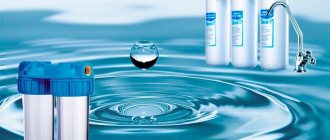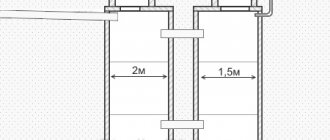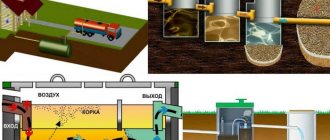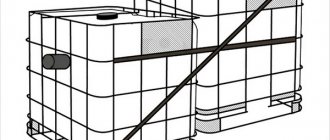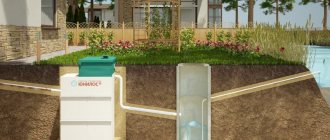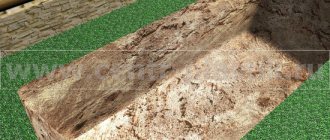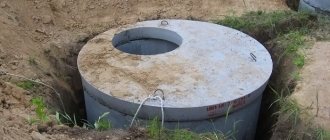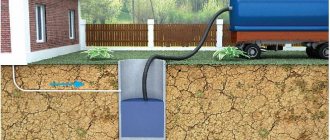Causes and signs of siltation
Sludge accumulation occurs in treatment systems of all types: septic tanks and cesspools with an open or closed bottom. Sludge is formed as a result of settling and processing of wastewater by bacteria. Signs of siltation are unambiguous: the layer on the bottom and walls of the septic tank increases and becomes denser. In this case, the water leaves slowly or stops leaving completely.
When a local environmental disaster becomes a reality, and the septic tank or cesspool quickly fills up; what to do is a question that requires an immediate response. To ensure that the situation does not repeat itself, it is useful to understand its causes; there may be several of them:
- Choosing an unsuitable septic tank design or errors in its installation . The trouble is that the critical level of siltation does not occur immediately, but after several years. There are only two options: either frequent pumping and cleaning, or replacing the septic tank.
It is better to entrust the installation of a septic tank to professionals Source ytimg.com
- The treatment system has not been used for a long time . The number of bacteria decreases, the remaining ones cannot be processed, and sludge accumulates.
- A lot of chlorine gets into the drain along with household chemicals . He uses scorched earth tactics and kills all microorganisms, including beneficial ones that utilize waste.
Self-made and temporary structures, in addition to silting, have their own reasons for overflow. If the water does not drain from the cesspool, the question of what to do is solved in a similar way, but the reasons are different:
- The amount of wastewater has increased, the volume of the pit is not enough.
- Soil characteristics : high clay content or periodic rise in groundwater level (during prolonged rains or melting snow).
- Severe frosts lead to freezing of the soil and freezing of drains, and the filling of the container is disrupted.
It is necessary to carefully calculate the possibility of installing a septic tank in clay soil Source landshaftdesign.org
See also: Catalog of companies that specialize in sewerage and water supply
Reasons for cleaning a septic tank
The septic tank is not a very complicated design. In it, waste accumulates, is cleaned thanks to the drainage system or the effective work of aerobic and anaerobic bacteria, and then the clean liquid flows into the ground (discharged outside). Since the sewerage system of a private house operates autonomously, it requires regular maintenance. There are several reasons for its need:
- Tank overfilling with solid deposits. If the sediment reaches the overflow level, it will cause great inconvenience to the owners and cause irreparable harm to nature.
- If people live in the house irregularly, then the septic tank, left over the winter with waste water, may freeze. In this case, the body and internal structure of the structure are at risk of damage, and the bacteria will die.
- Accumulation of waste, siltation. Solid sediment accumulating at the bottom, without cleaning, will compress and harden over time. Such a mass, which seriously impairs the performance of the equipment, will be much more difficult to remove.
Many owners of country houses are interested not only in the question of how to clean a septic tank with their own hands, but also in the frequency of this operation. As a rule, the sedimentation tank is cleared of sediment annually. If you leave this matter to chance, then after a few years a sediment will form in the structure, similar in consistency to clay.
The thicker the sediment layer, the more volume it takes away from the chambers. Therefore, such a septic tank will become less effective, since the quality of cleaning will significantly deteriorate. In some cases, even sewage disposal equipment cannot cope with “centuries-old” deposits: the pump is simply not able to pump out the heavy substance. Cleaning even once a year will avoid all the unpleasant consequences of sediment accumulation.
Primary cleaning methods
When a smell appears, a layer of sludge is visible through the inspection hatch of the septic tank with the naked eye, and the drainage pit quickly fills, there is only one answer to the question of what to do: clean. There are several stages in dealing with overflow and siltation.
Call for service
A sewer truck is the first step to restoring the normal operation of the septic tank (pit). Before dealing with sludge, you need to empty the container of the liquid fraction of the wastewater. To make the task easier, it makes sense to arm yourself with a hose and try to wash away the silty deposits with a high-pressure jet.
If the deposits are dense and cannot be removed, they can be softened using a pole or metal pipe. If you have time, and the sanitation workers have the desire, you can arrange a repeat pumping. To do this, you will have to fill the container with clean water again; this will take time (only if you do not prepare barrels of water in advance).
Pumping out a septic tank at the dacha Source 2gis.com
Mechanical cleaning
It, like any medicine, is not the most pleasant, but effective remedy if the cesspool has silted up; the answer to the question of what to do lies on the surface, literally and figuratively. The task is simple: use a shovel to remove a layer of sediment from all surfaces. The silt is lifted in buckets and transported outside the site (outside the outskirts). The recycling problem is easier to solve in rural areas.
Mechanical cleaning is an effective folk remedy with many advantages: it does not take much time, does not require financial investments and allows you to forget about overflow for a long time.
Mechanical cleaning works well when a hole dug in clay soil overflows. Additionally, you can perform the following operations:
- If the clay layer is not thick, deepen the hole until it ends.
- Use a drill to make several holes in the bottom to improve drainage.
- Install grease filters in the kitchen drain.
Household plastic grease trap for sink Source stroikairemont.com
How to clean with household chemicals
A septic tank product in the form of chemicals made from a nitrate oxidizer is the most effective and environmentally sound treatment of wastewater from autonomous sewer systems, especially in winter.
It is not difficult to organize the process of cleaning the sump with your own hands, by consistently following the recommendations of the instructions for a particular product.
Cleaning concrete structures is a complex process, unlike plastic septic tanks. On the walls of the chambers, grease and other waste deposits are retained due to the porosity of the material and are removed after complete decomposition.
To speed up waste processing, it is important to select preparations that are compatible with septic tank materials to clean the chambers of fatty deposits.
Knowledge of the use of chemical treatment products and the operation of treatment facilities will allow you to correctly select and use drugs that speed up the process of processing and purification of wastewater.
The use of chemicals to clean septic tanks from solid waste and grease deposits is especially important in winter, while microorganisms are preserved.
1. The chemical reagent "Devon-Il" helps remove plugs from sewage in the sewer system, dilutes hardened sludge deposits and waste.
For the effective action of the substance, in accordance with the instructions, you must:
- Pour 100 ml monthly into the home drain. Getting into the septic tank wells, it eliminates and dilutes solid waste and sludge;
- 0.5–1 l per 1 cubic meter. m of wastewater should be poured into the receiving chamber when pumping out liquid to neutralize the odor;
- pour 100–200 ml 3 times a day into the sewer system in the house or treatment facility to remove a large layer of silt or blockage.
Helper Methods
Chemical and biological methods are considered auxiliary. Their main purpose is the decomposition of hard and viscous deposits and trouble-free removal. In case of siltation after their use, a sewage disposal machine will be required to pump out the liquefied substrate.
Chemicals
The following types of chemical compounds are used to clean open storage tanks and septic tanks:
- Formalin . Liquid formaldehyde was previously used as an affordable and effective disinfectant. It destroys all living bacteria, but is a strong poison for people, so it is used less and less.
- Bleaching powder . The second drug, the use of which is recommended to be avoided. Lime is a proven disinfectant, but it is very toxic, so work with it in a respirator and gloves. It is stored in a dark place - in the light the substance loses active chlorine, and its effectiveness decreases.
When you can’t do without chemistry Source mantair.com
- Ammonium salt purifiers . The preparations contain nitrogen in a tetravalent active form. They intensively dissolve organic matter and eliminate unpleasant odors. At the same time, they are very toxic. Therefore, one of the main conditions for the task of how to clean a septic tank with ammonium salts is the remote location of the country toilet from residential buildings (ideally, at least 15-20 m from the house). To clean the waste pit, only vacuum pumping is suitable.
- Nitrate oxidizers (nitrogen fertilizers) . Compared to other chemicals, this is the most gentle option. Nitrate compounds decompose any organic matter, eliminate odor, and the result of their work can be used as fertilizer. The disadvantage of oxidizing agents is their high cost. When communications and the electric pump of a septic tank come into contact with metal, they form salt on the surface, which can lead to overgrowing of pipes and damage to the device.
Ammonium preparations are used away from housing Source ogorod.ru
How to clean a septic tank with your own hands?
The best option still remains an “invitation” to the site of sewage disposal equipment, but some owners, for very good reasons (impossibility of a car approaching, saving money, etc.), prefer to act independently. But before you start studying the question of how to clean a septic tank with your own hands, you need to know several features of this operation.
- Part of the activated sludge is always left because it is the “place of residence and work” of microorganisms. In order not to encounter an insufficient number of “bioworkers,” it is recommended to replenish the colony after each cleaning. First of all, this applies to anaerobic bacteria.
- Microbial populations are affected by chemical cleaners. In addition to chlorine, it is not recommended to use preparations containing acids, which can also lead to the death of bacteria. Perhaps the worst case scenario is the complete destruction of the colony.
Manufacturers recommend choosing the optimal method of colonizing microorganisms. Bacteria are inoculated through the sink or toilet, then flushed with sufficient water. The advantage of this option is the ability to clean the pipes from plaque: food residues and grease. Some microorganisms will settle on the walls and gradually clean them.
Mechanical cleaning
It should be noted that the highest quality cleaning of a septic tank is possible only with the help of sewer or sludge removal equipment. However, this approach is applied to structures without live assistants.
Vacuum truck
It allows you to spend a minimum of time, and the quality of cleaning will be incomparable to that achieved by manual labor. The advantages include the absence of the need to look for a place for “fished” waste. Mechanized pumping makes it possible to almost completely avoid exposure to “wonderful” aromas. Hoses allow you to carry out sewage cleaning work at a certain distance from the object being cleaned.
Sludge sucking equipment
Another name is silt suckers. The functionality of such machines is wider, and they also guarantee better suction of semi-solid deposits. In addition to the waste tank, the suction pumps have a reservoir for water, which, after pumping, is used to wash septic tanks and overflow pipes. The power of such machines is higher: the equipment is capable of working at a great distance from the object (30-50 m). The intake can be made from a depth of 10 m, the capacity of the liquid waste tank is 30 m3. This sludge sucker is ideal for servicing large structures.
Fecal pumps
Not all owners of private houses have the opportunity and desire to engage special equipment, so some owners have to do the work with their own hands. Naturally, a manual set consisting of a ladle and a bucket is not the best solution. For this simple reason, “sucking specialists” are used for dirty work - drainage fecal pumps.
The best option is fecal devices that include grinders for high-quality processing of solid inclusions. If independent work is not scary, then this method can be considered as an alternative to professional equipment. But in this case, you need to think in advance about where to pump out the waste. The container for their transportation must be completely sealed.
Factory septic tanks are most convenient, complete with pumps designed for pumping out uncompressed sludge. For example, Topas designs do not involve the use of a sludge-suction or sewage disposal machine, and information on how to work with pumping equipment can be found in the instructions for the “slop design”. The removed suspension is settled, then the liquid fraction is drained, and the solid component is used as fertilizer.
Approximately 20% of the sludge left in a structure is due to bacteria living there. After pumping out the wastewater, the walls of the structure, as well as filters (membranes), overflows are cleaned with water from a hose or brushes. If the filtration field is heavily silted, its drainage layers are also changed.
Biological, chemical treatment
This is the second answer to the question of how to clean a septic tank with your own hands. However, it should be noted that this method does not eliminate the need to pump out a semi-liquid substance; it is only an addition to the main operation. Biological products are added before manual cleaning. The time required for bacteria to do the job is indicated in their instructions.
Chemicals
The essence of chemical cleaning is the oxidation of biological waste, which, as a result of such exposure, decomposes much faster. The basis of such preparations is ammonium sulfate and formaldehyde, therefore, after treatment, sludge cannot be used as a fertilizer; it must be buried. In addition to liquid formaldehyde and ammonium salts, preparations based on other compounds are used.
- Bleaching powder. This is another remedy that is best avoided. Lime is a time-tested type of disinfection, but it is very toxic, so working with it is only possible with gloves and a respirator.
- Nitrogen fertilizers. If we compare these products with other chemicals, they can be considered a preferable, gentle option. Nitrate compounds can dissolve any organic matter, they eliminate odors, so the resulting waste can be used as fertilizer.
Nitrate oxidizers have disadvantages. This is a high price, possible damage (overgrowth) of metal elements due to deposits - salts formed on the surface of the pipes, and damage to pumping equipment.
Briefly about the main thing
Siltation develops in all treatment systems; this happens for various reasons. An external sign of sludge accumulation is the rapid filling of the waste tank and increased pumping.
To solve the problem, you need to determine the cause of the blockages. At the first stage, they call the sewer trucks to pump out the septic tank. The remaining sludge is removed from the bottom and walls mechanically. Dense sludge can be broken down using chemical or biological preparations.
To prevent siltation from reoccurring, preventive measures are carried out; the most effective method is biological. If the cause of siltation was the excessive use of chlorine-containing household chemicals, it will be limited in the future.
Ratings 0
How not to harm chemicals and how to use them correctly
You can only use detergents that are safe for septic tanks and do not contain chlorine, phosphates, acids, alkalis, or petrochemical elements.
Shampoos and hair conditioners, shower gels, toothpastes, soaps, perfumes, dishwashing liquid, etc. are not excluded. For example, Sinergetic is a biodegradable laundry liquid without chlorine.
When using chemicals and to improve the treatment of domestic wastewater and sedimentation tanks, it is necessary to obtain qualified information about the substance. It is important to know what the consequences may be from using the drug for bioflora in chambers and from purified water entering the ground.
When operating an autonomous sewage disposal system, it is important to understand what reasons can reduce the efficiency of waste processing, lead to malfunctions and stop the purification process:
- Seasonal use of the sewer system (only in summer). In this case, the bioflora may die and it will be necessary to re-establish the process of biological processing of sewage. During long breaks in the use of the sump, preservation preparations are used that quickly restore the functionality of microorganisms.
- Medicines that got through the sewer.
- Used household chemicals with antibacterial additives.
- Aggressive chemicals after cleaning.
Nitrate oxidizers clean wastewater disposal wells during periods of low bacterial activity, and in the summer they help get rid of hardened waste and dense sludge at the bottom of the sump, improving the drainage of purified water.
During constant operation of the treatment structure, including the winter period, chemical preparations for septic tanks are used that are able to withstand low temperatures without reducing activity.
Biological and chemical sludge removal
The chemical cleaning method does not replace other cleaning methods, but only complements them. The principle of operation is the oxidation of wastewater, which promotes the decomposition of biological residues. The preparations used are made on the basis of formaldehyde and ammonium sulfate. Due to its high toxicity, such sludge cannot be used as a fertilizer and must be buried.
The use of biologically active microorganisms accelerates the process of decomposition of mineral residues. As a result of waste processing, clarified water and a small amount of sludge are obtained.
Regular use of biological preparations (every 35-40 days) increases the interval between periodic mechanical cleaning, and the settled liquid can be drained into the soil without additional treatment.
What is necessary to ensure the smooth operation of a cesspool and septic tank
Let us summarize and formulate very briefly the basic rules that must be followed in the arrangement and operation of drainage sewer structures:
- Responsible approach to design. Strict compliance with technologies and SNiP standards. Access road for ambulance transport.
- Timely pumping out of liquid waste.
- Create an obstacle to siltation using biological and, if necessary, chemical agents.
- Removing solid deposits from surfaces using a powerful water jet.
- Continuous monitoring of the level of accumulated waste and the condition of surfaces.
Very simple rules that are easy to remember. If they are implemented, the drain autonomous storage device will serve for a long time and properly.


